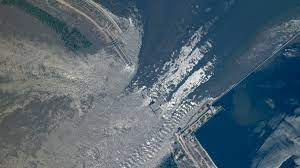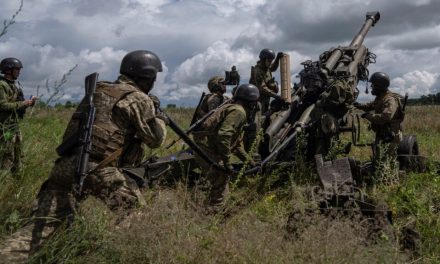ly after D-Day, a new dramatic development has taken place in southeastern Ukraine. In response to Ukrainian attacks, the Russian army blew up the dam in Nova Kakhovka with a giant flood below. It can probably be counted as the biggest deliberately caused flood disaster of all time. Can anyone think of any similar event in world history? In its scope it is similar to the biblical flood but with the difference that now it was not God but someone (some) in the Russian military leadership who made the apocalyptic decision.
The dam itself may not look that impressive in pictures but what you have to remember is that the dam shut off a really large collection of water from Ukraine’s largest river Dnieper (Dnipro) – the Kakhovka Reservoir, 240 kilometers long and up to 23 kilometers wide, with a surface of over 2100 km². With an average depth of just over 8.4 metres, it holds (according to Wikipedia) 18.2 km³ of water. Or escaped, until June 6, 2023, because now the water flows out over the villages downstream.

Everyone seems to agree that it is a clear and obvious war crime, in violation of express prohibitions against blowing up dams. Hopefully some war criminals will be brought to justice for this crime as well. Who it might be is currently not generally known, but I am pinning my hopes on a team of talented net scouts in e.g. Bellingcat will be able to pinpoint the culprits in this case as well.
However, not everyone seems to agree on who did the actual deed. In good journalistic spirit, most emphasize that, at the moment, there is no confirmed information about who blew up the dam in Kakhovka. Hardly unexpectedly, Russia put the blame on the Ukrainian side. Western commentators and the occasional politician seem to harbor no doubts and point out and/or condemn the Russian military. Are they right?
To try to determine who did it, we can right now – while we still have no concrete information – think a little about the circumstances surrounding the explosion.
First, in concrete terms, the Kakhovka Dam was on the Russian-controlled side of the river, which also constitutes a front line. It is confirmed that the Russian military has mined the dam already last year.
If the Ukrainians wanted to blow up the dam, they would have to send a special commando unit into Russian-controlled territory, cross a wide river/front line, enter a heavily guarded military area, detonate the mine device, and get out unscathed. The Russian side has not presented any information about fighting or enemy losses in connection with the explosion. Overall, it sounds like a story from The Guns of Navarone with Gregory Peck or The Heroes of Telemark with Kirk Douglas. Not impossible but far from likely.
We have become aware that Ukrainians in general are capable of very daring actions far beyond the country’s borders. Most recently, there are reports that it was a Ukrainian special commando with deep divers that blew up the Nord Stream pipeline. Likewise, it appears that Ukrainian agents are flying drones over the Kremlin. In the case of Kakhovka, however, it is considerably less likely.
Cui bono?
Instead, let’s take a closer look at who benefits from an act. Even the ancient Romans understood that it is often best to look at who benefits most from the deed in order to find the perpetrator. What do the Ukrainians have to gain by blowing up a dam and drowning a large part of their territory and population? Not very much if you ignore the theory that they blew up Kakhovka in order to blame the Russian side. By now, the list of the Russians’ heinous war crimes in Ukraine is so long that it doesn’t seem worth the trouble to try to make it even longer. One thing remains – that the disaster will disrupt the water supply on the Crimean Peninsula. It is therefore the only reasonable thing that would speak for Ukrainian responsibility for the dust explosion
From a military perspective – and these are considerations that apply to both sides right now – Ukraine had nothing to gain from the flood. On the contrary, the water flowing down the Dnieper in a wide field will create wetlands that will make it even more difficult to pass for the possibly attacking military. Now, if Ukrainians managed to cross the wide river between Kakhovka and Kherson, they would now be stuck in the mud created by the flood.
Conversely, the Russian side has something to gain from it – anything that makes the Ukrainian advance more difficult is good for the Russian side. Here we have the most likely motive for the act – to block possible Ukrainian attacks southeast of Kherson, that is, next to Crimea.

n addition, the terrain is not suitable for major operations with mechanized troops – first a wide river to cross and land on the other side, then a lot of existing wetlands with relatively few roads with solid surface. There are voices that believe that the Russian leadership simply panicked and blew up the dam to be on the safe side. Perhaps they were downright afraid of a Ukrainian commando raid in order to secure the easily accessible road OVER the dam?
The Russian side’s argument that they wouldn’t want to expose their own population in Crimea (or along the river) to danger or hardship just sounds like a joke.

SJokes aside, the Russians have now the opportunity to move units that would secure the area east of the Dnieper, between Kakhovka and Kherson. There are reports that troops are already on their way from there to the east, between Donetsk and Luhansk, where the major fighting appears to be taking place.




